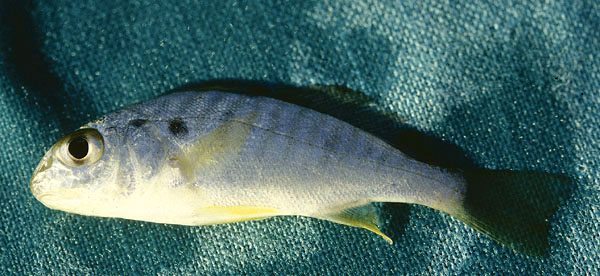
The Saltwater Magazine for Gulf Coast Fishing!

The Controversial Croaker
By John Hook
Gulf Coast Fisherman
Bay Naturalist Department
| CURRENT
MOON lunar phases |

The Croaker Controversy
To find a subject that gets folk's juices flowing like the croaker controversy you have to go back a few years to the net ban in Florida, and in Texas you'd probably go decades back to game fish status for redfish. These little drum family members sure cause a ruckus, but it hasn't always been that way. Just a few years ago the only thing arguable regarding croaker was whether or not you were a lower form of human if you kept them for dinner. That discussion would only get heated if someone from Texas wandered into a group of fishermen from the northern Gulf or maybe as far off as Virginia. In those days your area code determined whether croaker happily went on the stringer or were disdainfully cut up for bait.
Not any more. Waterfront neighbors are getting testy with each other if their yellow bait buckets contain croaker instead of shrimp and these arguments are sending ripples all the way to state capitals and beyond. The argument is rather simple. Is using live juvenile croakers for bait causing a reduction in the number of quality spotted seatrout?
That simple question has a not so simple answer but it's not really the croaker's fault. Bay fishermen have been taking large specks with live croaker for a very long time. The difference is that until recently most fishermen had to catch their own baitfish and so they were not used often. Now bait camps all around the Gulf are flying yellow croaker flags next to the classic white banner for live shrimp and it's availability that has made all the difference. Inexperienced anglers with impressive stringers of trout have become all too common to suit many bay veterans and croaker are to blame. Well, sometimes croaker are the offenders, but many times the blame should be placed on spot.
Spot, aka spot croaker or flat croaker, are even more common in most Gulf of Mexico bay systems than true croaker and are frequently sold as bait under the croaker label. It doesn't really matter as far as the controversy goes since trout gobble either with similar glee. They're so effective because these two species make up the majority of individual fish in Gulf bays from spring into summer when the juveniles move into bays after the winter spawn offshore. Many times they make up the greatest biomass as well, which is very important in an ecological context, so it really isn't surprising that they would be a primary prey species for predators like trout.
Actually, using croaker might make controlling the trout harvest easier. Since larger baits seldom kill undersize fish there is little hidden mortality. If sampling indicates a reduction in larger trout in the population then you can tinker with size limits, like only one fish over 25 inches, or number limits to bring things back to an acceptable equilibrium. So, the controversy is really more about personal ethics than biology and that is not so simple to manage.
I prefer the old controversy anyway. I started stringing larger croaker a long time ago in defiance of accepted South Texas bay fishermen standards, especially during the fall migration of mature fish from bay to Gulf. When 14-inch redfish were no longer legal game it seemed to me that their 14-inch cousins might be fine substitutes in redfish recipes. I got funny looks from strangers at the cleaning table and much worse from my buddies regardless of where we were. Funny how the abuse stopped at dinnertime! South Texas doesn't see many spot large enough to fill a skillet but much of the rest of the Gulf does and so they get to participate in the old controversy as well. In terms of table value I would say that croaker are indistinguishable from redfish of similar size and spot maintain the same type of relationship with black drum. Since there are strong parallels in their diets it stands to reason that analogy would hold. These drum pedigreed panfish can be fixed in a number of ways and since they are not very thick, quick cooking methods excel. One of our favorites is a variation of the classic redfish on the half shell. Since the filet is never turned on the grill having thin fillets allows the fish to cook through before the skin and scales burn badly, which is a real problem when using larger redfish.
Whichever croaker controversy inspires you to action it is good to know
that these fish are in good supply. Although, like many bottom fish, croaker
are susceptible to being heavily impacted by shrimping efforts and that
is another controversy altogether!

